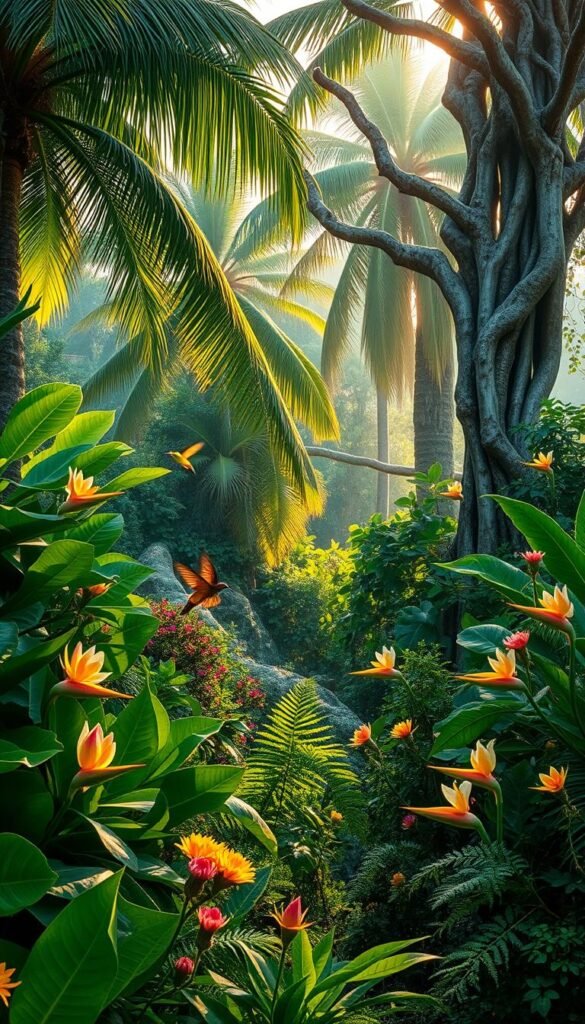What if your backyard could capture the harmony and wonder humanity has sought for millennia? For centuries, cultures worldwide have drawn inspiration from an iconic vision of natural perfection to shape their landscapes. This enduring concept blends wild abundance with thoughtful arrangement, offering both visual delight and soul-nourishing retreats.
You’ll uncover how ancient narratives transformed ordinary plots into living art. Discover design principles that balance free-growing foliage with strategic structure, mirroring the effortless elegance found in historical blueprints. These methods help craft spaces where every path invites exploration and every seating area feels like a hidden discovery.
Modern interpretations focus on layered textures and curated plant selections. Think feathery ferns softening stone walkways or vibrant flowers framing water features. This approach creates depth while maintaining that untamed-yet-intentional look synonymous with paradise-inspired designs.
Your journey through these time-tested ideas will reveal practical ways to infune your space with tranquility. From choosing plants that thrive in your climate to arranging seating for contemplative moments, you’ll learn to build a personal sanctuary that feels both magical and authentically yours.
Introduction to the Edenic Garden Concept
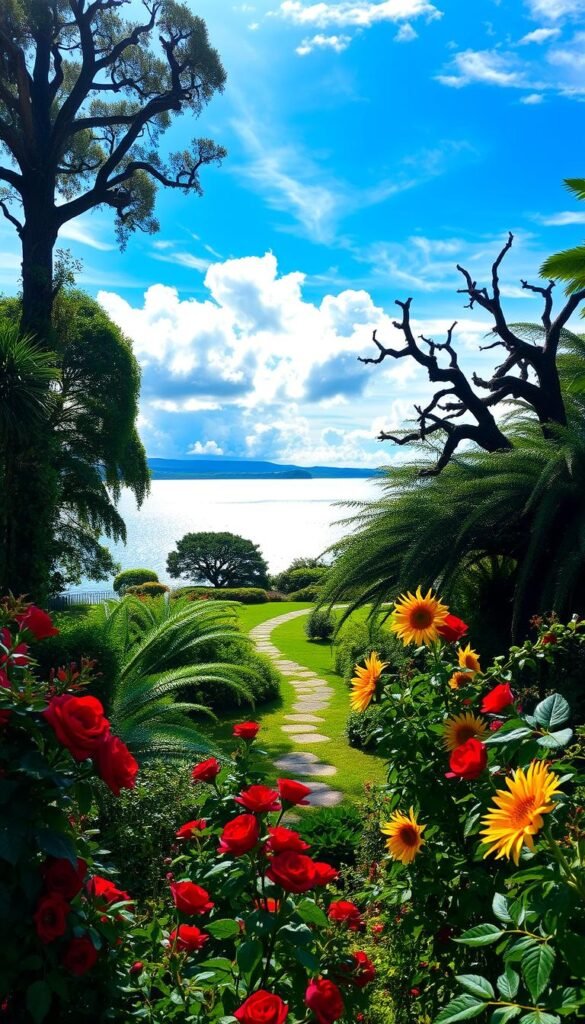
Imagine stepping into a space where every leaf whispers ancient secrets while fresh fruit hangs within reach. This vision of harmony between wild growth and human needs began over 2,500 years ago. Early Hebrew texts first painted Eden as a sanctuary where beauty and purpose grew side by side.
Understanding the Origins of Eden
The story starts in 500 BCE scriptures describing trees “pleasing to the eye and good for food.” Four rivers – Tigris, Euphrates, and two mysterious waterways – fed this lush paradise. You’ll notice how these elements still shape designs today: water features mirror life-giving streams, while fruit-bearing plants add both color and snacks.
Islamic traditions later expanded this idea, emphasizing gardens with reliable harvests and flowing water. These accounts reveal a shared human longing: spaces where nature’s chaos meets thoughtful design. Your backyard can echo this balance through strategic plant choices and soothing water elements.
The Modern Appeal of Paradise in Your Garden
Today’s versions blend old wisdom with new needs. Instead of forbidden knowledge, you get fragrant herbs by walkways and shaded seating nooks. The core principle remains: create areas that nourish body and soul. Think citrus trees doubling as natural art or a small pond reflecting sky and foliage.
By weaving these timeless ideas into your layout, you craft more than greenery – you build a living story. Each path becomes an invitation, every bloom a reminder of humanity’s enduring bond with earth’s abundance.
Historical Influence of the Garden of Eden
Few tales have shaped our green spaces like the story of Earth’s first paradise. This narrative didn’t just inspire religious thought – it became the blueprint for how we design outdoor sanctuaries across the Western world.
Sacred Texts as Design Manuals
Both Genesis and the Quran use vivid plant imagery to depict divine harmony. The Tree of Life appears as a central symbol in these accounts, often mirrored today by placing specimen trees as focal points. As one 16th-century landscape architect noted:
“Every proper garden needs its Adam – a central figure to tend the living artwork.”
These texts established key design principles:
| Element | Biblical Reference | Modern Application |
|---|---|---|
| Flowing Water | Four rivers of Eden | Fountains & streams |
| Edible Beauty | Fruit-bearing trees | Ornamental citrus |
| Sacred Center | Tree of Knowledge | Statement plantings |
Shaping Western Landscapes
Medieval cloister gardens first translated these ideas into physical spaces. Monks arranged herbs in geometric patterns, reflecting Eden’s balance between wild growth and human order. This evolved into:
- Renaissance parterres with intricate knot designs
- English cottage gardens blending flowers and vegetables
- Modern xeriscapes using drought-tolerant “Eden plants”
Today’s designers still reference the Adam Eve narrative when creating spaces for contemplation. Winding paths invite discovery, while secluded benches echo the idea of hidden knowledge waiting to be uncovered. This approach transforms backyards into living stories where every planting choice whispers ancient truths.
Garden of Eden Aesthetic: Lush Greenery and Exotic Blooms for a Paradise Feel
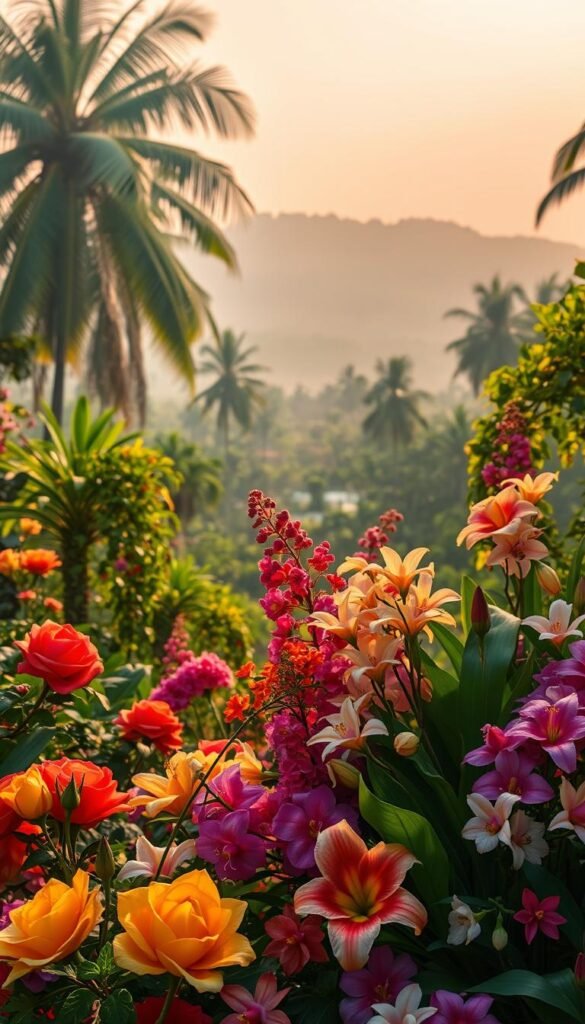
Ever wondered how to transform your space into a living masterpiece using nature’s finest materials? Start with snapdragons and stargazer lilies – their bold shapes command attention while creating vertical interest. Pair them with soft pink roses for a romantic counterpoint that whispers elegance.
Purple asters add depth to your color palette, their rich hues contrasting beautifully with golden solidaster blooms. These sunny accents create focal points that guide the eye through your design. For texture, incorporate seeded eucalyptus – its silvery leaves catch sunlight like nature’s own jewelry.
| Flower | Color Contribution | Design Role |
|---|---|---|
| Snapdragons | Vibrant spikes | Vertical structure |
| White spray roses | Crisp accents | Balance bold hues |
| Solidaster | Warm yellow | Light reflection |
| Seeded eucalyptus | Silver-green | Texture anchor |
Master fragrance layering by positioning scented varieties near seating areas. Stargazer lilies release their perfume at dusk, while roses offer daytime sweetness. This strategic placement creates evolving sensory experiences throughout the day.
Your plant combinations should tell a story of abundance. Mix feathery ferns with glossy camellia leaves to play with light and shadow. Let climbing vines soften stone walls, proving that beauty and function can coexist effortlessly in your personal sanctuary.
Designing Your Own Eden: Inspiring Garden Layouts
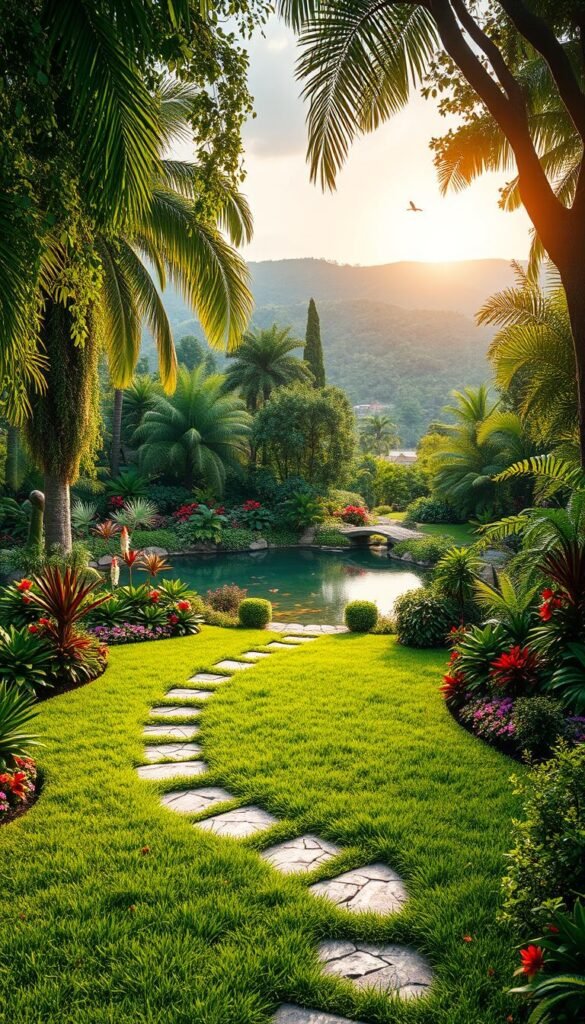
Your backyard holds potential to become more than plant beds – it can evolve into living art. Landscape historian John Hunt calls this “Third Nature,” where spaces balance wild beauty with thoughtful arrangement. Unlike functional farms, these designs prioritize visual harmony while still offering practical benefits like shade or fresh herbs.
Planning a Layout That Flows Naturally
Start with curved pathways that mimic Eden’s winding rivers. Gentle arcs guide movement while hiding surprises around each bend – maybe a stone bench under a flowering tree. This approach works particularly well when blending structured and freeform elements.
Mixing Formal and Natural Elements
Pair geometric hedges with billowing perennials for contrast. Try boxwood borders framing lavender clusters, or symmetrical stone planters overflowing with trailing vines. This balance creates rhythm without stiffness – like nature itself decided where each leaf should grow.
Layer heights to build depth: groundcovers as living carpets, mid-sized shrubs for body, and canopy trees for vertical drama. Add focal points like a circular pond or sculptural olive tree to anchor the design. Your space becomes a journey where every glance reveals new details worth contemplating.
The Role of Lush Greenery in Creating a Paradise Feel
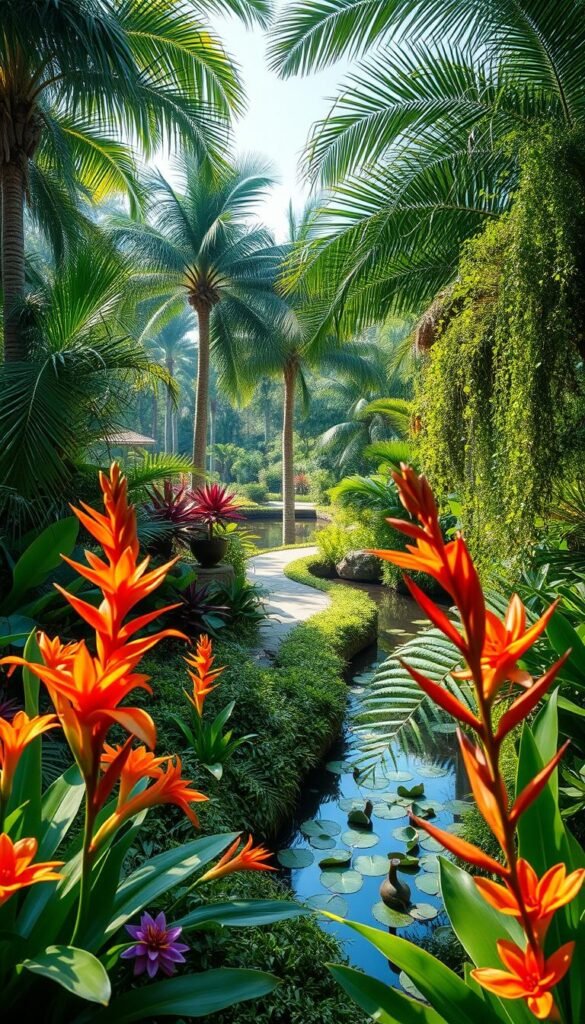
Your green sanctuary begins with smart plant partnerships that thrive in harmony. Start by observing native species in nearby forests or meadows – these natural performers already know how to flourish in your climate. Mimic their growth patterns while adding visual drama through varied leaf shapes and heights.
Selecting Plants That Speak to Nature
Choose trees and shrubs that serve dual purposes, like flowering dogwoods offering spring blossoms and fall berries. Evergreen magnolias provide year-round structure while their glossy leaves reflect sunlight. Consider these multi-taskers:
| Plant Type | Key Benefits | Examples |
|---|---|---|
| Trees | Vertical structure, shade | Redbud, Japanese maple |
| Shrubs | Texture, wildlife support | Hydrangea, viburnum |
| Groundcovers | Soil protection, continuity | Sweet woodruff, creeping thyme |
Layer plants to create natural microclimates. Taller specimens shelter shade-loving ferns, while sun-catching grasses warm nearby herbs. This approach lets you grow diverse species side by side, just like Eden’s legendary abundance.
Balancing Shade and Sun for a Vibrant Look
Position deciduous trees where summer shade protects delicate blooms but winter sun warms seating areas. Silver-leafed plants like lamb’s ear brighten shadowy corners, while golden hostas glow in filtered light. Rotate container plants seasonally to maintain color where sunlight shifts.
Remember: Your greenery forms the living canvas that makes flowers pop. Contrast feathery maidenhair ferns with bold elephant ears, or mix spiky yucca with flowing ornamental grasses. These combinations create depth while keeping maintenance manageable.
Exotic Blooms That Define an Edenic Garden
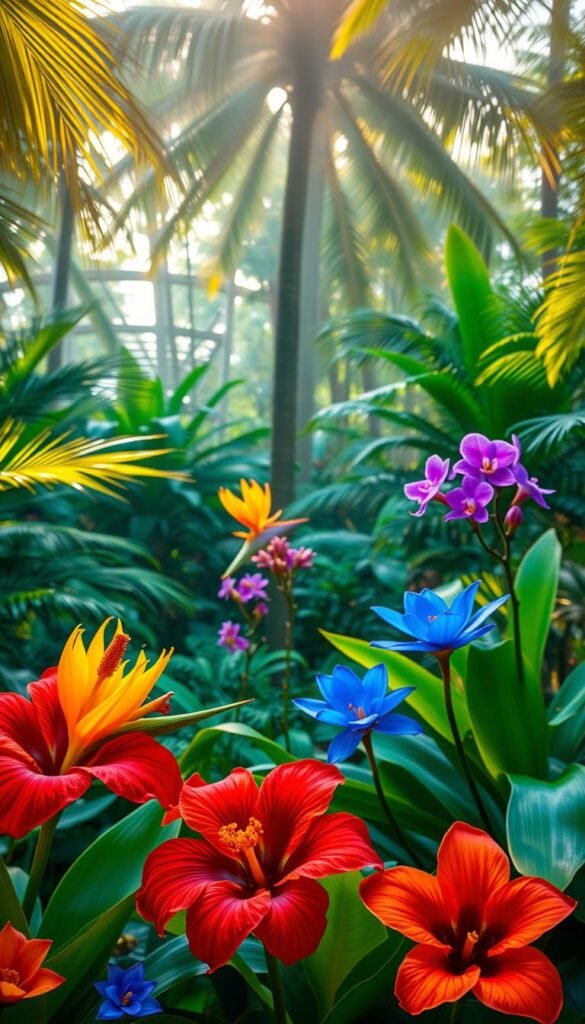
Transform your outdoor space into a sensory wonderland with blooms that tell stories of paradise. The right floral combinations create visual poetry, blending vibrant hues with intoxicating scents that linger in memory long after petals fall.
Incorporating Colorful Flowers Like Roses and Asters
Climbing roses like the ‘Eden’ variety become living tapestries with their deep pink ombré petals. Train them over arches to create natural doorways that bloom repeatedly from spring through fall. Pair these romantic showstoppers with purple asters for dramatic contrast – their star-shaped flowers pop against softer hues.
| Bloom | Visual Role | Seasonal Impact |
|---|---|---|
| Eden Rose | Vertical drama | Repeat blooms |
| Purple Aster | Color anchor | Late summer focus |
Choosing Unique Blooms to Set Your Garden Apart
Move beyond common varieties with exotic specimens that spark conversation. Consider bat-faced cuphea’s whimsical blooms or the electric blue spikes of salvias. These unexpected choices create focal points while maintaining that effortless elegance central to paradise-inspired designs.
Layer fragrant night-bloomers like moonflowers near seating areas. Their luminous white petals release scent after sunset, transforming your space into an evening retreat. Combine these with textural grasses that sway in twilight breezes for multi-sensory magic.
Your floral selections should work like nature’s brushstrokes – bold in places, delicate in others. Cluster shorter blooms near pathways where their beauty invites close inspection, while taller varieties frame vistas. This strategic placement turns every glance into a discovery, keeping the paradise feel alive through changing seasons.
Integrating Historical and Cultural Elements in Modern Garden Design
What if ancient blueprints could solve modern design challenges? Across continents, cultures developed outdoor spaces blending spiritual meaning with practical beauty. These time-tested approaches offer fresh solutions for today’s landscapes.
Drawing Inspiration from Persian and Islamic Gardens
The iconic Charbagh layout—four quadrants divided by waterways—mirrors Islamic visions of paradise. You can adapt this concept using geometric flower beds flanking a central fountain. The 16th-century Fin Garden in Iran demonstrates how precise symmetry creates harmony between human order and natural growth.
Learning from Botanical Collections and Traditional Designs
Major plant collections showcase Eden’s legendary diversity through curated groupings. Try clustering plants by texture or origin story rather than just color. This approach transforms your space into a living museum of botanical art.
Water remains central to cultural narratives. Narrow channels inspired by Moorish designs cool summer air while adding soothing sounds. For a contemporary twist, pair these with mixing vintage and modern elements like corten steel planters beside aged stone paths.
Your space becomes a dialogue across eras when you balance tradition with innovation. Let historical knowledge guide layouts while choosing plants suited to your climate. The result? A garden that feels both timeless and uniquely yours.
Gardening Trends Influenced by Edenic Aesthetics
Have you noticed how today’s landscapes echo ancient visions of abundance? Contemporary designs increasingly blend wild textures with structured elements, creating spaces that feel both free and intentional. This approach mirrors humanity’s enduring quest for harmony between nature and nurture.
Water features now serve as ecological assets, not just decorations. Rain chains guide runoff into fern-lined basins, while recirculating streams support aquatic plants. Edible flowers like nasturtiums edge vegetable plots, merging beauty with practicality – a modern twist on Eden’s fruitful legacy.
Plant choices reveal a shift toward sustainable luxury. Homeowners mix native species with climate-adapted exotics, prioritizing low-water perennials over thirsty annuals. Vertical gardens transform fences into living tapestries, maximizing small spaces without sacrificing lushness.
These trends prove paradise isn’t lost – it’s being reimagined. By weaving timeless inspiration into earth-conscious practices, you craft spaces that nourish both soil and soul. Your personal sanctuary becomes part of a greener future rooted in nature’s original blueprint.

